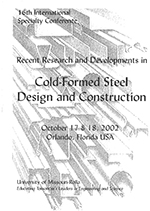Behaviour of Cold-formed Thin-walled Steel Short Columns with Service Holes At Elevated Temperatures
Session Dates
17 Oct 2002
Abstract
This paper presents the results of an experimental and numerical investigation into the axial strength of cold-formed thin-walled lipped channel sections with service holes under ambient and uniform high temperature conditions. Short columns of two different thickness with service holes under different temperatures have been tested, and analysed by using a variety of design methods and a commercial finite element program ABAQUS (1998). Three design methods (the British Standard BS5950 Part 5 (1987), Eurocode 3 Part 1.3 (CEN 1996) and the American Specification AISI (1996)) have been used in this paper. In the finite element analysis, both geometrical and material non-linearities are taken into account. The high temperature stress-strain relationships of steel are determined according to Eurocode 3, Part 1.2 (CEN 1995) and Outinen (1999, 2000, 2001). To enable BS5950 Part 5 (1987) and Eurocode 3 Part 1.3 (CEN 1996) to predict the ultimate strength of thin-walled columns with service holes, the AISI (1996) design method is introduced. To extend the capacity of the three design methods to deal with distortional buckling, the method of Young and Hancock (1992) for calculating distortional buckling capacity is introduced in these codes. The ambient temperature design methods for thin-walled columns in BS5950 Part 5 (1987), Eurocode 3 Part 1.3 (CEN 1996) and the AISI specification (1996) are modified to take into account changes in the strength and stiffness of steel at elevated temperatures. It is found that service holes can have a significant effect on the load capacity of a column regardless of the column temperature when thicker members are used. From extensive comparisons between the test results, modified codes' predictions and numerical analyses, it may be concluded that by adopting the aforementioned modifications, the current code design methods are suitable for evaluating the buckling behaviour of perforated short columns at elevated temperatures.
Department(s)
Civil, Architectural and Environmental Engineering
Research Center/Lab(s)
Wei-Wen Yu Center for Cold-Formed Steel Structures
Meeting Name
16th International Specialty Conference on Cold-Formed Steel Structures
Publisher
University of Missouri--Rolla
Document Version
Final Version
Rights
© 2002 University of Missouri--Rolla, All rights reserved.
Document Type
Article - Conference proceedings
File Type
text
Language
English
Recommended Citation
Feng, M.; Wang, Y. C.; and Davies, J. Michael, "Behaviour of Cold-formed Thin-walled Steel Short Columns with Service Holes At Elevated Temperatures" (2002). CCFSS Proceedings of International Specialty Conference on Cold-Formed Steel Structures (1971 - 2018). 1.
https://scholarsmine.mst.edu/isccss/16iccfss/16iccfss-session4/1
Behaviour of Cold-formed Thin-walled Steel Short Columns with Service Holes At Elevated Temperatures
This paper presents the results of an experimental and numerical investigation into the axial strength of cold-formed thin-walled lipped channel sections with service holes under ambient and uniform high temperature conditions. Short columns of two different thickness with service holes under different temperatures have been tested, and analysed by using a variety of design methods and a commercial finite element program ABAQUS (1998). Three design methods (the British Standard BS5950 Part 5 (1987), Eurocode 3 Part 1.3 (CEN 1996) and the American Specification AISI (1996)) have been used in this paper. In the finite element analysis, both geometrical and material non-linearities are taken into account. The high temperature stress-strain relationships of steel are determined according to Eurocode 3, Part 1.2 (CEN 1995) and Outinen (1999, 2000, 2001). To enable BS5950 Part 5 (1987) and Eurocode 3 Part 1.3 (CEN 1996) to predict the ultimate strength of thin-walled columns with service holes, the AISI (1996) design method is introduced. To extend the capacity of the three design methods to deal with distortional buckling, the method of Young and Hancock (1992) for calculating distortional buckling capacity is introduced in these codes. The ambient temperature design methods for thin-walled columns in BS5950 Part 5 (1987), Eurocode 3 Part 1.3 (CEN 1996) and the AISI specification (1996) are modified to take into account changes in the strength and stiffness of steel at elevated temperatures. It is found that service holes can have a significant effect on the load capacity of a column regardless of the column temperature when thicker members are used. From extensive comparisons between the test results, modified codes' predictions and numerical analyses, it may be concluded that by adopting the aforementioned modifications, the current code design methods are suitable for evaluating the buckling behaviour of perforated short columns at elevated temperatures.



